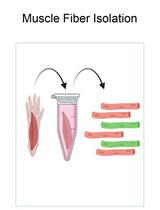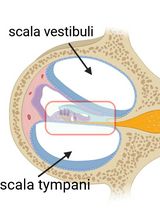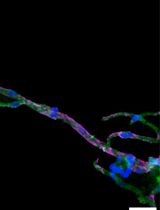- EN - English
- CN - 中文
Aorta Atherosclerosis Lesion Analysis in Hyperlipidemic Mice
高血脂小鼠中的主动脉粥样硬化病变分析
发布: 2016年06月05日第6卷第11期 DOI: 10.21769/BioProtoc.1833 浏览次数: 22172
评审: Ruth A. FranklinRakesh BamAnonymous reviewer(s)
Abstract
Atherosclerosis is a chronic inflammatory disease of large and medium-sized arteries. Apolipoprotein E-deficient (ApoE-/-) mice are used as experimental models to study human atherosclerosis. ApoE-/- mice are constitutively hyperlipidemic and develop intima plaques that resemble human plaques. Various issues including experimental design for lesion analysis, dietary conditions, isolation of the aorta, staining methods, morphometry, group size, age, the location within the arterial tree, and statistical analyses are important parameters that need to be addressed to obtain robust data. Here, we provide detailed methods to quantify aorta atherosclerosis.
Keywords: Atherosclerosis (动脉粥样硬化)Materials and Reagents
- Petri dish sets, glass (VWR International, catalog number: 89000-306 )
- Black dissection wax (CR Scientific, catalog number: C3541 )
- Minutien pins (0.15 mm diameter) to fix the aorta (Fine Scientific Tools, catalog number: 26002-15 )
- 50 ml Falcon tube (VWR International, CellStar®, catalog number: 188271 )
- 10 ml syringe (BD, catalog number: 309695 )
- 20 ml syringe (BD, catalog number: 301625 )
- Sterican single use needles-23G (B. Braun Medical Inc., catalog number: 4657640 )
- Poly-L-lysine coated glass slides (Menzel Glaeser, catalog number: J2800AMNZ )
- Coverslips (Menzel Glaeser, catalog number: BBAD02400500#A )
- OHP permanent marker pen (STAEDTLER MARS LIMITED)
- Microscope slide holder/mailer, 5 place (Sigma-Aldrich, catalog number: Z708313-25EA )
- Cryogenic freezer storage box (VWR International, catalog number: 82021-114 )
- Staining jar with cover (VWR International, catalog number: 25460-907 )
- Grade 410 filter paper (VWR International, catalog number: 28321-077 )
- Polystyrene petri dishes (150 mm x 15 mm) (Sigma-Aldrich, catalog number: P5981 )
- Ethanol (Merck Millipore Corporation, catalog number: 1009832500 )
- Ethylenediaminetetraacetic acid (EDTA) (Sigma-Aldrich, catalog number: E6758 )
- Phosphate buffer saline (PBS) (Sigma-Aldrich, catalog number: P4417-100TAB )
- Paraformaldehyde (PFA) (Sigma-Aldrich, catalog number: 16005 )
- Sucrose (Sigma-Aldrich, catalog number: S0389 )
- Isopropanol (Merck Millipore Corporation, catalog number: 1096341011 )
- Acetone (Merck Millipore Corporation, catalog number: 1000141000 )
- Isopentane (VWR International, catalog number: 103614T )
Note: It is also named “2-Methylbutan” on VWR International website. - Dry ice (TKD KABEL GmbH)
- Sudan IV (Sigma-Aldrich, catalog number: 198102 )
- OCT compound-Tissue-Tek (SAKURA FINETEK USA, catalog number: 4583 )
- Cryomold (SAKURA FINETEK USA, catalog number: 25608-924 )
- Oil Red O (Sigma-Aldrich, catalog number: 00625 )
- Hematoxylin solution, Mayer’s (Sigma-Aldrich, catalog number: MHS-16 )
- Faramount aqueous mounting medium (Dako, catalog number: S3025 )
- Distilled water
- NaOH
- Sudan IV staining solution (see Recipes)
- Oil Red O (ORO) working solution (see Recipes)
- EDTA (see Recipes)
- PBS (see Recipes)
- Paraformaldehyde (PFA) (see Recipes)
- Sucrose (see Recipes)
- PFA-sucrose (see Recipes)
- Black wax petri dish (see Recipes)
Equipment
- CO2 supply machine (Next Advance, model: Quietek CO2 induction system )
- Dissection scissors (Fine Science Tools, catalog number: 91460-11 )
- Fine iris scissors (Fine Science Tools, catalog number: 14094-11 )
- Spring scissors (Fine Science Tools, catalog number: 15009-08 )
- Curved forceps (Fine Science Tools, catalog number: 11073-10 )
- Delicate suture tying forceps (Fine Science Tools, catalog number: 11063-07 )
- Dissection stereo microscope equipped with fibre-optic light source from top (Carl Zeiss Microscopy, model: Stemi 2000 )
- Measuring scale (LACO)
- Camera (Nikon, model: D5300 )
- -80 °C freezer (Thermo Fisher Scientific)
- Cryostat microtome (Microm GmbH, model: HM500 OM )
- Precision hotplate (HARRY GESTIGKEIT GMBH, model: PZ28-2T )
- Axio-Imager A2 microscope equipped with Axiovision release 4.8 software (Carl Zeiss Microscopy, model: 490022-0002-000 )
Software
- Statistical analysis software [IBM SPSS Statistics 20.0 (IBM Corporation, Released 2011, NY, USA)]
- Image J software [National Institutes of Health (NIH), USA]
- Axiovision release 4.8 software (Carl Zeiss)
Procedure
文章信息
版权信息
© 2016 The Authors; exclusive licensee Bio-protocol LLC.
如何引用
Mohanta, S., Yin, C., Weber, C., Hu, D. and Habenicht, A. J. R. (2016). Aorta Atherosclerosis Lesion Analysis in Hyperlipidemic Mice. Bio-protocol 6(11): e1833. DOI: 10.21769/BioProtoc.1833.
分类
细胞生物学 > 组织分析 > 组织分离
您对这篇实验方法有问题吗?
在此处发布您的问题,我们将邀请本文作者来回答。同时,我们会将您的问题发布到Bio-protocol Exchange,以便寻求社区成员的帮助。
Share
Bluesky
X
Copy link















